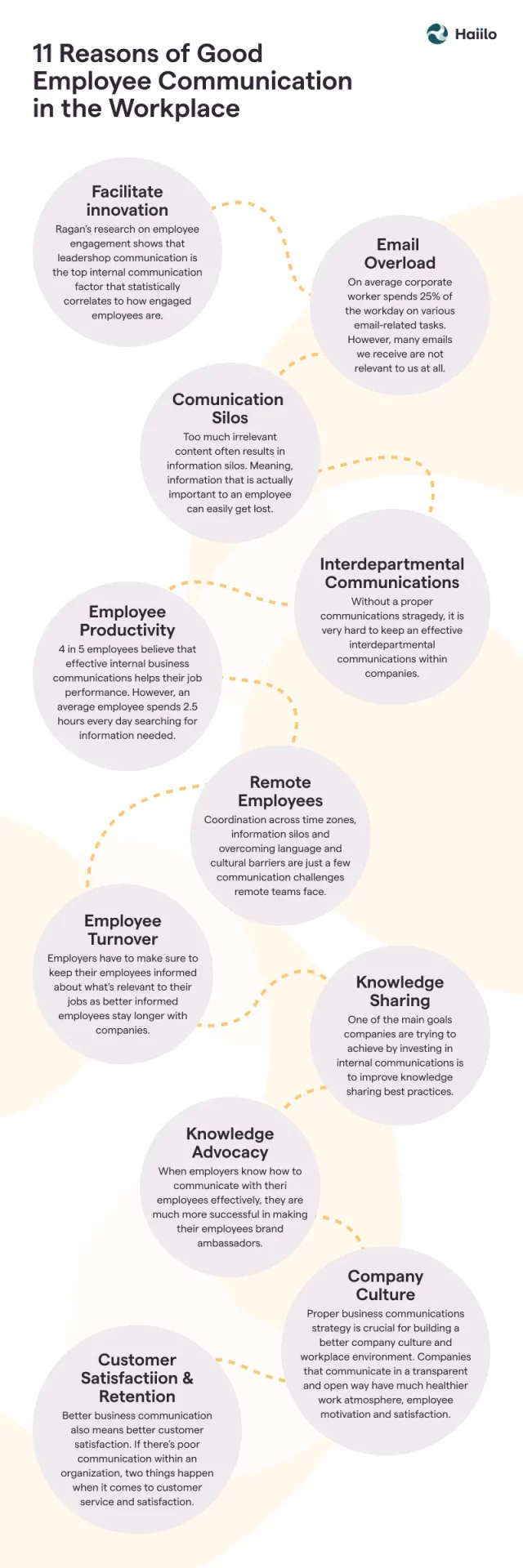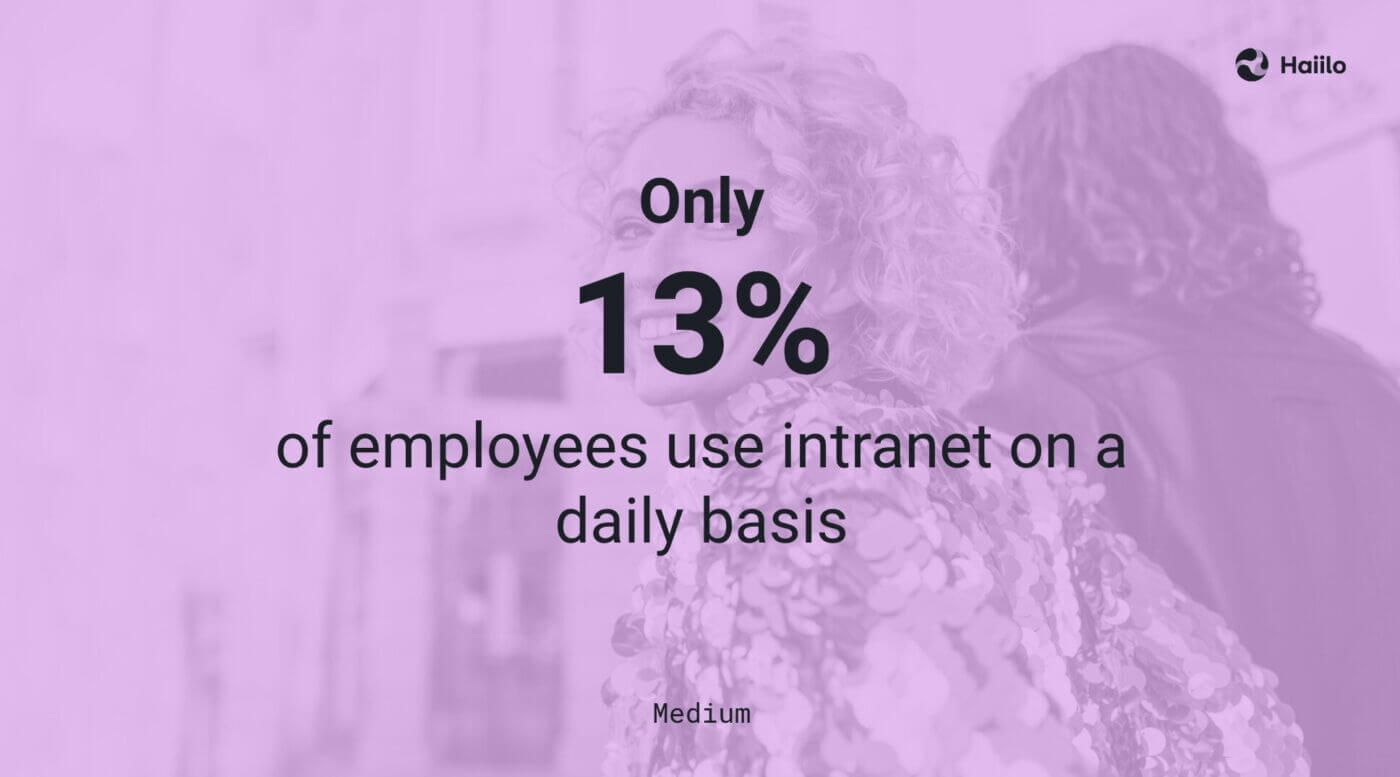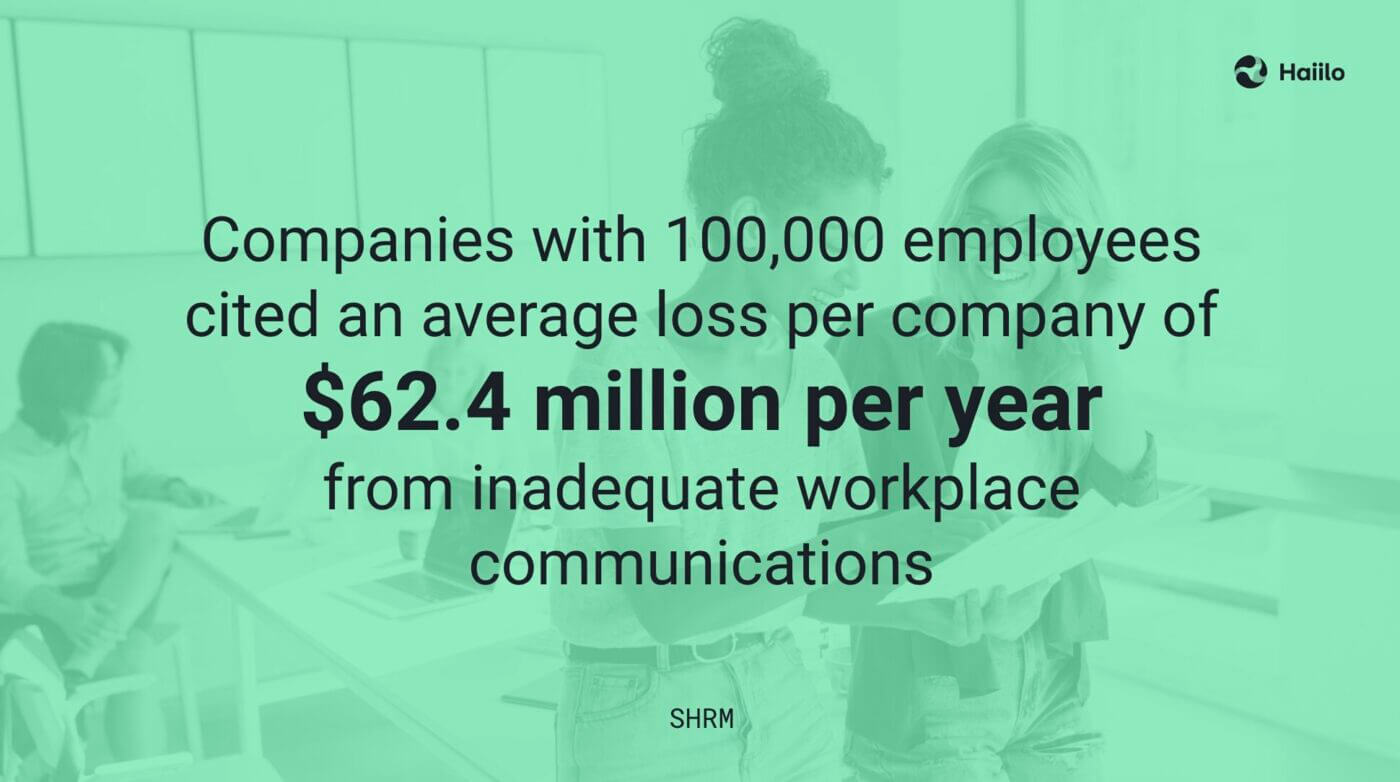Organizational communication is one of the essential prerequisites for building a successful business. Its impact on employee engagement, collaboration, workplace trust and employee experience makes it an important part of every workplace strategy.
📚Check out our article on Top Leadership Skills and become the leader your employees need.
In this blog, we will go over some of the most important benefits of building effective organizational communication, as well as the steps needed to implement a successful organizational communication strategy.
Build an effective organizational communication strategy with the right IC tool.
What Is Organizational Communication?
Organizational communication includes formal and informal communication throughout an organization, including communication among employees and employee-manager communication.
We can divide organizational communication into 4 main types:
1. Formal communication
Being formal, clear and specific is a great way to ensure a proper flow of information in the workplace. With formal communication, everyone is informed about and aligned with the business goals.
This type of communication is also required to meet legal requirements. For example, work arrangements, as well as safety rules and guidelines, have to be communicated to the employees in a formal way (emails, printed documents).
📚Learn about the importance of interpersonal communication!
2. Informal communication
As you might have guessed, this type of communication is the opposite of formal communication. It is also known as “grapevine communication“. In essence, it includes dialogues, chats, phone conversations as well as the “water cooler talks” that usually take place near the coffee maker that don’t rely on any formalities.
One of the top advantages of informal communication is the fact that it is a faster way of sharing information in the workplace. It also helps share and develop new ideas to improve products as well as internal or external processes. You would be surprised to know how many innovation ideas started with a chat next to the coffee machine!
📚 Learn about how to tackle grapevine communication in the workplace!
3. Horizontal communication
This type of organizational communication occurs amongst teams, groups, or individuals at the same hierarchical level. Horizontal communication plays an important role in breaking down silos and improving cross-departmental collaboration in the workplace. It plays a critical role in aligning tech, marketing and sales teams and making sure that everyone is on the same page.
📚 Check out these 8 tips for boosting employee communication in your organization!
4. Vertical communication
The most common form of communication within structured organizations follows an up-and-down vertical pattern. It includes communication between business leaders, team leaders and employees. This type of communication is essential in the workplace. Without vertical communication, it wouldn’t be possible to share guidelines, feedback, or ideas.
No matter what type of communication we are talking about, communication in the workplace is a vital management component to any organization.
Some of the main purposes of organizational communication are to update employees on new policies, crisis communication, ensure safety throughout the organization, manage change management, digital transformation, mergers and acquisitions as well as give and receive feedback from employees.
📚Read on: Change Management: Definition, Best Practices & Examples
To be successful, organizations should have comprehensive organizational communication strategies in which employees feel informed about the important company updates and are engaged in daily organizational conversations.
📹 Before we move forard, check out our Masterclass: How to Create an Internal Comms Strategy.
15 Goals of Effective Organizational Communication
Effective organizational communication impacts organizational success in many ways. Some of them include:
- Creating a positive employee experience increases employee morale, satisfaction and engagement.
- Helping employees understand the terms and conditions of their employment and driving their commitment and loyalty.
- Encouraging employees’ share of voice significantly improves employees’ satisfaction with their employer.
- Helping to decrease misunderstandings and the spread of misinformation in the workplace.
- Improving cross-departmental communication and collaboration among employees.
- Helping employees align with the company’s mission, vision and core values.
- Driving higher employees engagement by keeping employees informed at all times.
- Making it easy for employees to find important and relevant information whenever they need it.
- Streamlining the flow of information within the organization.
- Improving employee productivity by eliminating waste of time spent on information search and communication on irrelevant topics.
- Improving processes and procedures and ultimately creating greater efficiencies and cost reductions.
- Building better relationships between employees and their managers.
- Improving trust in the workplace.
- Making communication more fun.
- Improving communication with non-wired, remote and deskless employees.
Check out the infographic below where we share some of the most important benefits of communication in the workplace 👇

9 Steps to Create a Successful Organizational Communication Strategy
Let’s now go over the 9 crucial steps for creating a successful organizational communication strategy at your organization.
1. Link your organizational communication plan to your business strategy
Most HR, internal communication strategists and organizational leaders agree that linking organizational communication to their business strategy is essential to effective and consistent business operations.
Yet, many organizations still don’t have an internal communication plan and strategy in place.

To develop an effective organizational communication strategy, employers should begin by linking communication to their overall strategic plan, including the organization’s mission, vision and core company values.
📚Read on: Company Values: Definition, Importance and Examples
For example, your business strategy may be to improve performance by increasing employee retention or employee engagement.
As employee communication plays a crucial role here, your organizational communication strategy should be directly linked to your business strategy.
2. Understand your audience/s
Identifying your audience is an important step for ensuring the effectiveness of your organizational communication strategy.
One of the main causes of ineffective organizational communication is the fact that employers don’t segment their audiences based on their job roles, departments, locations, interests and preferences.
As a consequence, most employees get a similar type of information even though that information may not be relevant to them at all.
What happens then?
Very low engagement and consumption rates with your internal communication content.
As this is something all communicators are trying to eliminate and avoid, defining and understanding your internal audiences is a crucial step for developing a good organizational communication strategy.
3. Engage all employees
Organizational communication is the process in which all employees should be involved and participate in.
The mindset in which communication mainly includes delivering messages to employees about business issues, policies and procedures, and company updates is the wrong mindset.
Communication in the workplace should never be one-way. Two-way conversations, on the other hand, have a great power to create and support a healthy workplace culture. Listening to employee issues, questions, comments, ideas and concerns builds loyalty and drives employee productivity.
At the end of the day, everyone in the organization has a role in building an organizational communication strategy that works well:
- CEOs and senior managers are ultimately responsible for setting the tone and establishing a great organizational culture. One of the main responsibilities these leaders have is ensuring effective company-wide communication.
- The HR professionals and other people strategists also play critical roles in organizational communications, especially in today’s workplace where employees’ expectations, preferences and needs have changed significantly.
- Managers and team leaders are responsible for daily communication with their employees.
- All employees have a responsibility to share their voice, their concerns and issues, provide feedback and collaborate with their teammates.
📚Read on: 8 Employee Engagement Statistics You Need to Know in 2020 [INFOGRAPHIC]
4. Create engaging and relevant content
Unfortunately, many employees don’t engage with their company’s internal content. Moreover, many employees ignore messages being delivered to them through a company’s intranet or email.
This happens mostly because the content delivered to them is not relevant to what they do. Sending out a mass employee newsletter to all employees hoping that they will read it is not realistic at all today.
An effective organizational communication strategy requires much more than that. As IC practitioners are now seen as important strategic business partners, their new role is to step up their game by ensuring that the internal content actually gets consumed by employees.
However, content and audience segmentation, especially in large organizations, is impossible without the right employee communication tools that enable communicators to create and distribute more engaging content to the employees.
📚 Check out our new guide for driving employee engagement in the workplace!
5. Distribute your content through the right channels
Now even if you have the right content ready and you know who should receive it, there is another important factor to consider: the communication channels you’re going to use to distribute your content.
As the number of different communication channels we use in the workplace is continuously increasing, choosing the right channels becomes a big challenge for communicators.
📚Read on: Top Communication Channels to Consider for Your Business
Intranets, emails, internal social media, private messaging apps such as Slack, document sharing, and project management tools are all means of internal communication in organizations.
Therefore, this communication ecosystem has become very complex and hard to manage efficiently.
For this reason, many organizations are now turning to modern employee communication solutions that enable them to implement a successful multichannel communications strategy.
6. Implement the right communication technology
Choosing the right employee communication technology can really bring your organizational communication strategy to the next level.
If you know that engagement levels through your current solutions are low, that is probably a sign that something needs to be changed.
Many intranets are still outdated and they don’t match employees’ preferences regarding the way they communicate even in their private lives.

Therefore, the implementation of mobile-first employee communication solutions is not an option any more, it’s a must-have!
If we know that the majority of our workplaces is made by Gen Z and millennial workers, we also know how much time they spend and communicate via their smartphones.
Therefore, switching to mobile-first internal communication solutions like Haiilo Stories is guaranteed to transform the way your workplace communicates.
7. Measure the outcomes
While most organizations agree that measuring and quantifying results of communication plans is necessary, this goal is difficult to accomplish.
Moreover, 60% of IC practitioners are still not measuring their internal communication efforts.
Tracking and measuring internal communication efforts is extremely important to understand what is working well and what needs to be improved.
Collecting this data can help you answer questions such as:
- How engaged your employees are with your internal content?
- How do they respond to your messages?
- What communication channels are the best to deliver information?
- What type of content employees engage the most with?
- Which employees engage the most (likes, shares, comments)?
8. Use your data to improve your organizational communication strategy
Once you collect and analyze data, it is easier to make improvements and better decisions in the future.
For example, if you realize that your employees engage most with video content, this is the sign to produce more of such content.
Moreover, video truly is the type of content younger generations love to consume because of its simplicity and fun.

Another great way to leverage data is to understand who your internal influencers are in order to reward them and make them your brand ambassadors.
📚Read on: Top 5 Communication Skills and How to Improve Them
With Haiilo Stories, companies across the world have managed to transform their organizational communication efforts with the help of data available through our employee communications solution.
9. Leverage the power of AI in internal communications
Since the introduction of OpenAI and ChatGPT, many forward-looking internal communications professionals have started investigating how to leverage AI to work smarter and make a bigger impact on overall business success.
Luckily, there are many different ways artificial intelligence can be used to improve organizational communication.
For example, AI and machine learning can be leveraged to deliver the right content in front of the right people at the right time, and through the right channel, resulting in a much bigger readership and engagement with future communications.
Advanced internal communications platforms leverage AI to analyze user activity, understand employee interests, and predict future engagement. Based on data, communicators can identify specific employee profiles, create segments (based on locations, job functions, departments, and many others), and get recommendations around what type of content employees are likely to engage the most with.
10. Watch your workplace transform
This is the best step of your newly implemented organizational communication strategy!
If you can successfully implement all the above steps, your whole workplace culture will transform. Your employees will be much more satisfied with their jobs and the company overall which will result in higher employee engagement and productivity levels.
Even though this process may not seem easy to implement, the hard work will pay off and your return on investment will be obvious.
The Cost of Poor Organizational Communication
As seen earlier in this blog post, organizational communication is a topic that businesses should concentrate more on. However, according to research from the Society for Human Resource Management (SHRM), many companies are losing money due to poor communication.
One survey of 400 companies with 100,000 employees cited an average loss per company of $62.4 million per year from inadequate communication to and between employees.
In addition, miscommunication cost smaller companies of 100 employees an average of $420,000 per year.

Moreover, ineffective communication may increase misunderstandings, damage relationships, break trust, lower employee productivity and increase frustration in the workplace.
Boost Your Organizational Communication Strategy with Haiilo
Haillo is the leading employee communications platform that enables and empowers HR and internal communications professionals to make workplace communications more impactful and successful.
With the platform you can:
- Have a single source of truth where employees can find important and relevant information in seconds. AI-powered search delivers answers instead of links, significantly reducing time spent on information search.
- Segment your internal audiences based on various criteria, ensuring greater readership and engagement with the content employees can relate to.
- Measure your employees’ pulses with intuitive and smart surveys
- Easily create engaging multimedia content. With generative AI you never have to start creating content from scratch, and you can create content 10 times faster!
- Distribute content to multiple internal channels with a single click, ensuring greater reach.
- Measure the impact of your organizational communications initiatives on the overall business success.











